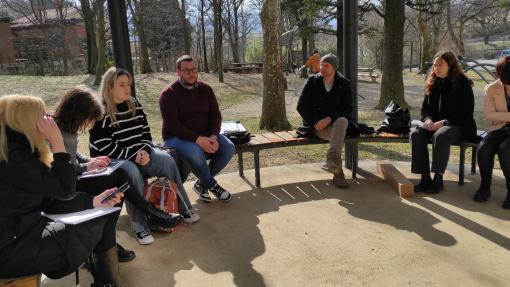At the end of February 2025, we hosted the fourth partner meeting of the GRENNAT project in Ajdovščina. On a sunny Monday, all project partners from both Italy and Slovenia attended the meeting. The main purpose of the meeting was to present the current status of each partner's project activities, along with the plan for their completion.
The review of the project's progress confirmed that most project activities are well underway. The Municipality of Ajdovščina is preparing technical documentation for the renaturation of the floodplain area along the Hubelj River, as well as project documentation for the construction of a footbridge over the Hubelj and the regulation of the confluence of the Hubelj and Lokavšček rivers. The Consorzio di Bonifica Venezia Giulia partner successfully upgraded the fish ladder and installed a measuring station on the Soča River, and the establishment of a multimedia and promotional point in Sagrado is progressing well. The Municipality of Miren-Kostanjevica is setting up an educational trail at the Bilje Clay Pit. The Municipality of Monfalcone is developing an educational thematic trail at the Cavana di Monfalcone and an information point for Natura 2000 in Marina Julia. Additionally, they are preparing a brochure highlighting the characteristics of habitats and the relationship between agriculture and nature conservation, three press releases, and a press conference to spread information about the cross-border project activities within the GRENNAT project. The project partner Consorzio di Bonifica Veneto Orientale has already installed permanent stations for monitoring surface water and groundwater stations, which will form the basis for collecting data and preparing a report on the collected data. An irrigation management application is under development. The Municipality of Nova Gorica is currently conducting a student workshop on green infrastructure in urban and suburban areas near protected areas and natural values, aiming to develop conceptual designs for the area along the Soča River. This will be followed by the preparation of an implementation plan for the development of the area along the Soča River. The investment at Rihemberk Castle, related to improving the conditions for the bat species living there, is in its final phase. Plans are also in place to prepare an implementation and planting plan for the Lijak area.
Based on the review of the project's activities, we also assessed their anticipated completion. We concluded that more time than originally planned will be needed to successfully complete all activities, mainly due to unfavorable weather conditions, increased workload, the inclusion of unfinished studies, the need for an extended monitoring period of the fish fauna and water conditions, and the more extensive presentation of project results at the promotional point and at the end of the project. As a result, the meeting concluded with a clearer timeline for the upcoming spring months.

